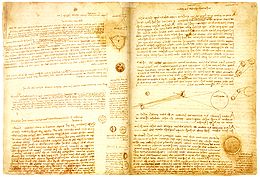- Codex Leicester
-
For the Greek minuscule manuscript of the New Testament also known as Codex Leicester, see Minuscule 69.
The Codex Leicester (also briefly known as Codex Hammer) is a collection of largely scientific writings by Leonardo da Vinci. The codex is named after Thomas Coke, later created Earl of Leicester, who purchased it in 1717. Of Leonardo's 30 scientific journals, the Codex may be the most famous of all.
The Codex provides an insight into the inquiring mind of the definitive Renaissance artist, scientist and thinker as well as an exceptional illustration of the link between art and science and the creativity of the scientific process.
The manuscript does not take the form of a single linear script, but is rather a mixture of Leonardo's observations and theories on astronomy; the properties of water, rocks, and fossils; air, and celestial light. The topics addressed include:
- an explanation of why fossils can be found on mountains. Hundreds of years before plate tectonics became accepted scientific theory, Leonardo believed that mountains had previously formed sea beds, which were gradually lifted until they formed mountains.
- the movement of water. This is the main topic of the Codex. Among other things, Leonardo wrote about the flow of water in rivers, and how it is affected by different obstacles put in its way. From his observations he made recommendations about bridge construction and erosion.
- the luminosity of the moon. Leonardo speculated that the moon's surface is covered by water, which reflects light from the sun. In this model, waves on the water's surface cause the light to be reflected in many directions, explaining why the moon is not as bright as the sun. Leonardo explained that the pale glow on the dark portion of the crescent moon is caused by sunlight reflected from the Earth. Thus, he described the phenomenon of planetshine one hundred years before the German astronomer, Johannes Kepler, proved it.
Physically, the Codex takes the form of 18 sheets of paper, each folded in half and written on both sides, forming the complete 72-page document. At one time the sheets were bound together, but they are now displayed separately. It was handwritten in Italian by Leonardo, using his characteristic mirror writing, and supported by copious drawings and diagrams.
The Codex was purchased in 1980 by wealthy industrialist and art collector Armand Hammer from the Leicester estate, and renamed the Codex Hammer.[1]
In 1994, Bill Gates bought it at an auction for US$30.8 million, making it the most expensive book ever sold, and he subsequently renamed it the Codex Leicester.[2]
The Codex is put on public display once a year in a different city around the world. In 2004, it was exhibited in the Château de Chambord, and in 2005 in Tokyo. One page was exhibited at the Seattle Museum of Flight's 2006 exhibit "Leonardo da Vinci: Man, Inventor, Genius." From June to August 2007, the codex was the centerpiece of a two-month exhibition hosted by the Chester Beatty Library in Dublin, Ireland.
After Gates acquired the Codex, he had its pages scanned into digital image files, some of which were later distributed as screen saver and wallpaper files on a CD-ROM as Microsoft Plus! for Windows 95. A comprehensive CD-ROM version (simply titled Leonardo da Vinci) was released by Corbis in 1997.
See also
References
Further reading
- Thereza Wells, ed (2008). Notebooks of Leonardo da VInci, selected by Irma A. Richter. Oxford World's Classics (new ed.). Oxford: Oxford University Press. ISBN 9780199299027.
- Jean Paul Richter (1970). The Notebooks of Leonardo da Vinci. Dover. ISBN 0-486-22572-0. volume 2: ISBN 0-486-22573-9. A reprint of the original 1883 edition.
External links
- American Museum of Natural History site for 1996-1997 exhibit of the Codex
- Seattle P-I site for 1997 Seattle Art Museum exhibit of the Codex, including background info
- News report of Japan opening, September 2005
- Leonardo da Vinci : The Codex Leicester
- Chester Beatty Library, Dublin, Ireland
Leonardo da Vinci Paintings †Medusa · **The Baptism of Christ · The Annunciation · *Ginevra de' Benci · *The Madonna of the Carnation · *Benois Madonna · St. Jerome in the Wilderness · The Adoration of the Magi · The Virgin of the Rocks (Louvre version) · *Lady with an Ermine · *Portrait of a Musician · *Madonna Litta · *La belle ferronnière · The Last Supper · *Madonna of the Yarnwinder · Mona Lisa · Head of a Woman · The Virgin of the Rocks (London version) · †The Battle of Anghiari · †Leda and the Swan · The Virgin and Child with St. Anne · *Salvator Mundi · St. John the Baptist · *Bacchus
Sculpture Leonardo's horse (unexecuted)Works on paper Manuscripts Codex Arundel · Codex Atlanticus · Codex on the Flight of Birds · Codex Leicester · Codex Trivulzianus · A Treatise on PaintingOther projects Categories:- 16th-century books
- Scientific illuminated manuscripts
- Bill Gates
- Codices by Leonardo da Vinci
Wikimedia Foundation. 2010.

